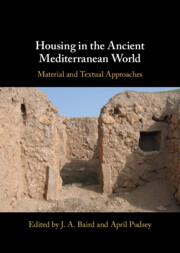Book contents
- Housing in the Ancient Mediterranean World
- Housing in the Ancient Mediterranean World
- Copyright page
- Contents
- Figures
- Tables
- Contributors
- Acknowledgements
- Introduction
- 1 Kinship ‘In the Halls’
- 2 Domesticating the Ancient House
- 3 Mind the Gap
- 4 A Family Affair
- 5 Textiles in Alkestis’ thalamos
- 6 Architectural Rhetoric and the Rhetoric of Architecture
- 7 The Reconstruction of an Agricultural Landscape
- 8 Mudbricks and Papyri from the Desert Sand
- 9 Housing and Community
- 10 The Elusive vestibulum
- 11 Living in the Liminal
- 12 Experiencing Sense, Place and Space in the Roman Villa
- 13 Houses and Time
- 14 Spaces of Desire
- 15 A Response: ‘Using the Material and Written Sources’ Revisited
- Index
- References
15 - A Response: ‘Using the Material and Written Sources’ Revisited
Published online by Cambridge University Press: 08 July 2022
- Housing in the Ancient Mediterranean World
- Housing in the Ancient Mediterranean World
- Copyright page
- Contents
- Figures
- Tables
- Contributors
- Acknowledgements
- Introduction
- 1 Kinship ‘In the Halls’
- 2 Domesticating the Ancient House
- 3 Mind the Gap
- 4 A Family Affair
- 5 Textiles in Alkestis’ thalamos
- 6 Architectural Rhetoric and the Rhetoric of Architecture
- 7 The Reconstruction of an Agricultural Landscape
- 8 Mudbricks and Papyri from the Desert Sand
- 9 Housing and Community
- 10 The Elusive vestibulum
- 11 Living in the Liminal
- 12 Experiencing Sense, Place and Space in the Roman Villa
- 13 Houses and Time
- 14 Spaces of Desire
- 15 A Response: ‘Using the Material and Written Sources’ Revisited
- Index
- References
Summary
Penelope Allison’s 2001 article on using material and written sources to study Roman domestic space has framed the debate on the topic more broadly for ancient world housing. In this chapter, she revisits that contribution and responses to it, and surveys the theoretical and methodological frameworks of the chapters in the volume. By examining the nature of the data, analytical and interpretative approaches to them, and the research questions, Allison assesses the extent to which the two decades since her critique have produced more critically engaged scholarship, particularly in approaches to relationships between textual and material evidence.
- Type
- Chapter
- Information
- Housing in the Ancient Mediterranean WorldMaterial and Textual Approaches, pp. 470 - 494Publisher: Cambridge University PressPrint publication year: 2022



